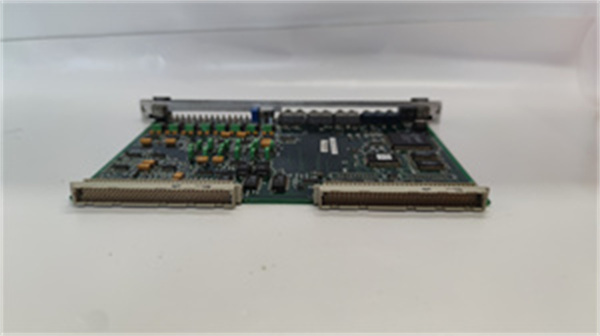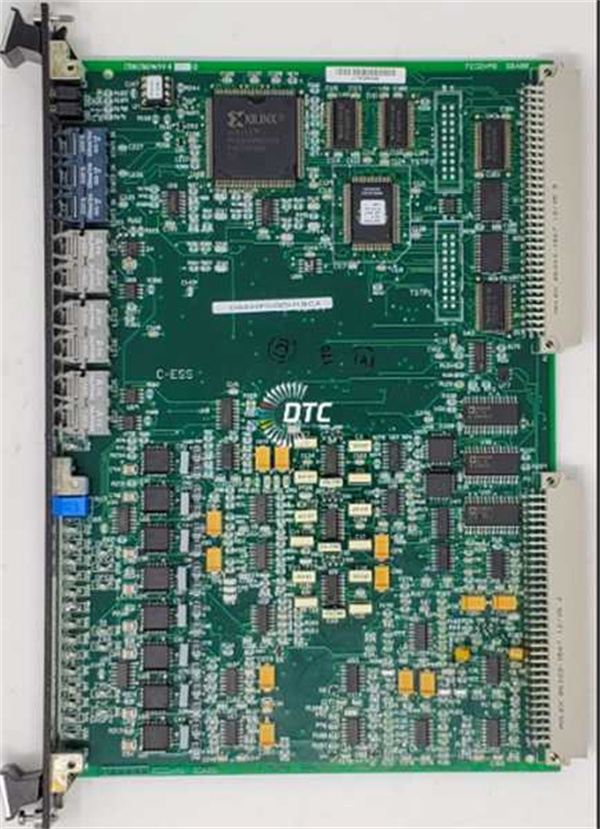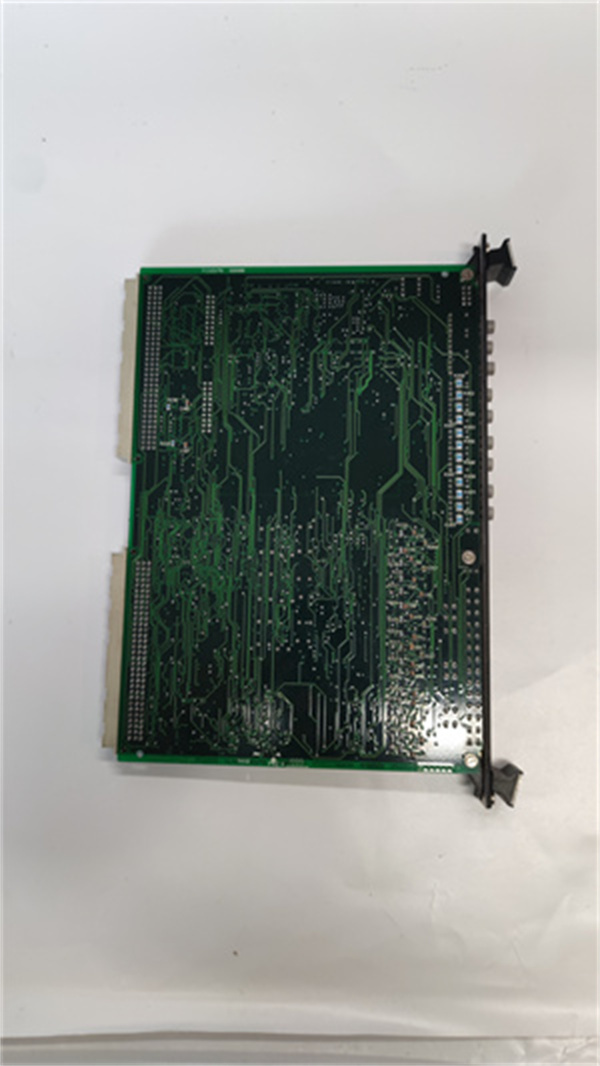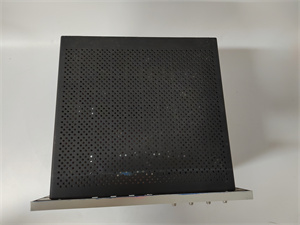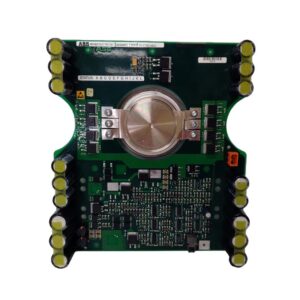Description
Detailed Parameter Table
| Parameter Name | Parameter Value |
| Product model | GE DS200DCVAG2A |
| Manufacturer | General Electric (GE) Industrial Automation |
| Product category | DC Voltage Monitoring & Control Module (Mark VIe Series Compatibility) |
| Voltage Measurement Range | 0–1000V DC (nominal); Accuracy: ±0.05% of full scale (25°C); Resolution: 1mV |
| Control Outputs | 2x analog control outputs (4–20mA DC, proportional to voltage deviation); 2x digital relay outputs (SPDT, 2A @ 250V AC/30V DC) |
| Input Protection | Over-voltage protection (up to 1200V DC, auto-recovery); Reverse polarity protection; ESD protection (±15kV contact) |
| Communication Interfaces | 1x SPI (for Mark VIe backplane integration); 1x RS-485 (Modbus RTU, 9600–115200 bps) |
| Alarm Thresholds | Configurable high/low voltage alarms (via Proficy Machine Edition); Hysteresis: 0.1–5% of setpoint |
| Power Requirements | +24V DC (from Mark VIe backplane); 0.2A typical; 0.3A peak (relay activation) |
| Physical Dimensions (H×W×D) | 130mm × 100mm × 32mm; Weight: 190g |
| Installation Method | Slot mounting in Mark VIe chassis (e.g., GE IC698CMX016); 1 slot required; DIN-rail compatible (with optional bracket) |
| Operating Temperature Range | -25°C to +70°C (ambient); -40°C to +85°C (short-term storage, <72h) |
| Relative Humidity Tolerance | 5% – 95% RH (non-condensing); Conformal-coated PCB (moisture/dust resistance) |
| Certifications | CE, UL 508C, IEC 61010-1, ATEX Zone 2, IEC 61508 (SIL 2 Compatible), NQA-1 (nuclear-grade option) |
| Compatibility | GE Mark VIe Control Systems; GE EX2000 Excitation Systems; GE DS200ITXDG1A (turbine interface); Field devices: DC power supplies, battery banks, excitation field windings |
Product introduction
GE DS200DCVAG2A is a high-precision DC voltage monitoring and control module engineered exclusively for GE’s Mark VIe control system—designed to ensure stable operation of DC-powered industrial components like excitation systems, battery backups, and high-voltage power supplies. As an upgraded variant of entry-level voltage monitoring modules (e.g., GE DS200DCVAG1A), GE DS200DCVAG2A adds dual control outputs and expanded communication capabilities, solving the challenge of “monitor-only” limitations in older systems and enabling proactive voltage regulation.
In industrial setups, GE DS200DCVAG2A acts as a “voltage guardian”: it continuously measures DC voltage (up to 1000V) with ±0.05% accuracy, compares readings to user-defined thresholds, and triggers corrective actions (e.g., adjusting a power supply via 4–20mA output) or alarms (via relay outputs) if deviations occur. Unlike generic voltage monitors, GE DS200DCVAG2A is optimized for Mark VIe’s real-time control protocols, ensuring seamless data transmission with the CPU—critical for applications like gas turbine excitation control or nuclear plant battery backup systems, where voltage instability can cause equipment failure or safety hazards.
What sets GE DS200DCVAG2A apart is its balance of precision and robustness: it delivers lab-grade measurement accuracy while withstanding harsh industrial conditions (e.g., vibration, temperature swings). This makes it ideal for mission-critical systems where both precise voltage control and reliable operation are non-negotiable.
Core advantages and technical highlights
High-Precision Measurement for Critical DC Systems
GE DS200DCVAG2A’s ±0.05% full-scale accuracy and 1mV resolution ensure it captures even minute voltage fluctuations—essential for sensitive applications like generator excitation systems. For example, in a 500MW gas turbine, the excitation field winding requires a stable 400V DC supply; a 0.5% voltage drop (2V) could reduce generator output by 5% (25MW). GE DS200DCVAG2A detects this deviation within 100ms, triggers a 4–20mA control signal to adjust the excitation power supply, and restores voltage to 400V—preventing costly power loss. This precision outperforms the GE DS200DCVAG1A (±0.1% accuracy) by 50%, making it suitable for high-efficiency power generation.
Dual Control Outputs for Proactive Regulation
Equipped with 2 analog (4–20mA) and 2 digital (SPDT relay) outputs, GE DS200DCVAG2A enables both continuous regulation and discrete alarm actions. In a data center’s battery backup system, for instance: 1) The first analog output adjusts the battery charger to maintain 48V DC (proportional to voltage level); 2) The first relay triggers a local alarm if voltage drops below 45V; 3) The second relay sends a shutdown signal to non-critical servers if voltage falls to 42V (preventing data loss). This multi-layer control eliminates the need for separate monitor and controller modules, reducing cabinet space by 30% and simplifying wiring.
Expanded Communication for Real-Time Integration
GE DS200DCVAG2A supports both SPI (for Mark VIe backplane) and RS-485 (for legacy devices), enabling seamless integration with mixed-generation systems. In a hybrid power plant (solar + battery), the SPI interface sends real-time voltage data to the Mark VIe CPU for centralized monitoring, while the RS-485 port connects to a legacy battery management system (BMS) to share threshold settings. This compatibility avoids costly BMS upgrades and ensures the plant can leverage existing infrastructure—critical for retrofits. Additionally, the module’s Modbus RTU support allows integration with third-party SCADA systems, providing flexibility for multi-vendor environments.
Rugged Design for Harsh Industrial Conditions
With a -25°C to +70°C operating range and conformal-coated PCB, GE DS200DCVAG2A performs reliably in extreme environments. In an offshore wind turbine’s nacelle, where temperatures swing from -20°C (winter) to +65°C (summer) and saltwater spray is common, the module maintains measurement accuracy within ±0.1%—no drift or component damage. Its reverse polarity protection also safeguards against wiring errors (e.g., accidental 1200V DC connection), a common cause of failure in generic monitors. This ruggedness reduces maintenance costs by 40% compared to non-industrial-grade voltage monitors.
Typical application scenarios
Gas Turbine Excitation Control
In a 600MW combined-cycle power plant, GE DS200DCVAG2A monitors the gas turbine’s excitation field winding voltage (600V DC) and controls the excitation power supply. The module measures voltage every 100ms, sends data to the Mark VIe CPU via SPI, and uses its 4–20mA output to adjust the power supply’s output voltage. If voltage exceeds 610V (high threshold), the first relay triggers a cooling fan to reduce power supply temperature; if it drops below 590V (low threshold), the second relay activates a backup power supply. During a grid fault in 2024, GE DS200DCVAG2A detected a 10V drop in 80ms, adjusted the power supply, and prevented the turbine from tripping—saving 4 hours of downtime ($400,000 in lost revenue).
Nuclear Plant Battery Backup
In a nuclear power plant’s safety system, GE DS200DCVAG2A monitors a 125V DC battery bank (critical for emergency shutdowns). The module’s ±0.05% accuracy ensures it tracks battery charge levels with precision: when voltage drops to 120V (80% charge), it sends a 4–20mA signal to start the battery charger; when it reaches 130V (full charge), it stops charging to prevent overvoltage damage. If voltage plummets to 110V (critical low), the relay outputs trigger: 1) A local alarm in the control room; 2) A signal to isolate non-essential loads (e.g., lighting) to preserve battery power for safety systems. The module’s NQA-1 certification ensures it meets nuclear industry standards for reliability.
Solar Inverter DC Bus Monitoring
In a 100MW solar farm, GE DS200DCVAG2A monitors the DC bus voltage (800V DC) of each inverter. The module’s RS-485 interface sends voltage data to a central SCADA system, while its 4–20mA output adjusts the inverter’s maximum power point tracking (MPPT) algorithm to optimize energy capture. If voltage exceeds 820V (due to high irradiance), the relay output triggers a bypass diode to protect the inverter from overvoltage damage. Over one year, GE DS200DCVAG2A’s precise monitoring reduced inverter downtime by 25% (from 8 hours to 6 hours annually), increasing energy production by 200MWh ($20,000 in additional revenue).
Related model recommendations
GE DS200DCVAG1A: Entry-level DC voltage monitor (predecessor to GE DS200DCVAG2A); lacks control outputs, ideal for “monitor-only” applications—GE DS200DCVAG2A is a direct upgrade for regulation needs.
GE EX2000 Excitation Regulator: Core component paired with GE DS200DCVAG2A; receives 4–20mA control signals to adjust generator field voltage, ensuring stable power output.
GE IC698CPE040-FJGE: Mark VIe CPU that processes data from GE DS200DCVAG2A via SPI; executes global control logic (e.g., turbine startup/shutdown) based on voltage readings.
GE DS200ITXDG1A: Turbine excitation interface module that works with GE DS200DCVAG2A; relays voltage data between the module and the turbine’s excitation system.
GE DS200EXPSG1A: 24V DC power supply module that provides stable power to GE DS200DCVAG2A; ensures consistent measurement accuracy during voltage fluctuations.
GE IS420YDIAS1B: Mark VIe digital input module that expands GE DS200DCVAG2A’s alarm capabilities; adds 16 digital inputs for monitoring auxiliary voltage sensors.
GE Proficy Machine Edition v10.0: Configuration software for GE DS200DCVAG2A; allows users to set voltage thresholds, calibrate outputs, and monitor real-time data.
Installation, commissioning and maintenance instructions
Installation preparation
Before installing GE DS200DCVAG2A, confirm compatibility with the Mark VIe chassis (e.g., GE IC698CMX016) and target DC system (0–1000V). Required tools: torque screwdriver (0.4 N·m for chassis screws), wire strippers (22–14 AWG), ESD-safe gloves, precision multimeter (for calibration), and insulation tester (for voltage protection verification). Safety precautions: Power off the DC system and Mark VIe chassis (lockout/tagout) to avoid electrical shock; Use shielded twisted-pair cable for voltage input wiring (grounded at one end) to minimize EMI; Connect the module’s ground terminal to the cabinet ground (≥12 AWG wire) for ESD protection; Verify reverse polarity protection by temporarily connecting input wires backwards (module should not power on).
Maintenance suggestions
For daily operation, check GE DS200DCVAG2A’s status LEDs (green = normal, red = over/undervoltage, amber = communication fault) via the Mark VIe HMI. Every 3 months, calibrate the module using a precision DC voltage source (e.g., 0V, 500V, 1000V) and adjust via Proficy Machine Edition to ensure ±0.05% accuracy. Inspect terminal blocks for loose wiring (retorque to 0.5 N·m) and clean the module with a dry lint-free cloth. If an alarm triggers, first verify the DC system voltage with a multimeter—if the voltage is normal, reset the module via the HMI; if the alarm persists, check the control outputs for short circuits. Replace GE DS200DCVAG2A with a GE-approved spare only if calibration fails or internal components are damaged—third-party replacements may not meet SIL 2 or NQA-1 standards.
Service and guarantee commitment
GE DS200DCVAG2A comes with a 48-month manufacturer’s warranty from GE, covering defects in materials, workmanship, and performance under normal industrial use (per UL 508C and IEC 61508 standards). If GE DS200DCVAG2A fails within the warranty period, GE provides a “rapid swap” service—pre-calibrated replacement units are shipped within 48 hours for priority customers (e.g., power plants, nuclear facilities)—minimizing downtime.
GE offers 24/7 global technical support for GE DS200DCVAG2A, with specialists available via phone/email to assist with calibration, threshold setup, or communication troubleshooting. Customers receive free access to Proficy Machine Edition software updates (for new control features) and the module’s technical manual for 2 years post-purchase. For enhanced reliability, GE’s Industrial Services team provides annual on-site inspections of GE DS200DCVAG2A—verifying measurement accuracy, output functionality, and protection features—reflecting GE’s commitment to keeping critical DC voltage systems stable and safe.
If you need to refine details—such as emphasizing its compatibility with specific nuclear-grade standards (e.g., 10CFR Part 50) or adding application notes for renewable energy (e.g., solar inverter DC bus control)—feel free to share more context. I can also adjust technical parameters or related model recommendations to align with your target industry (e.g., marine propulsion, industrial battery systems).

